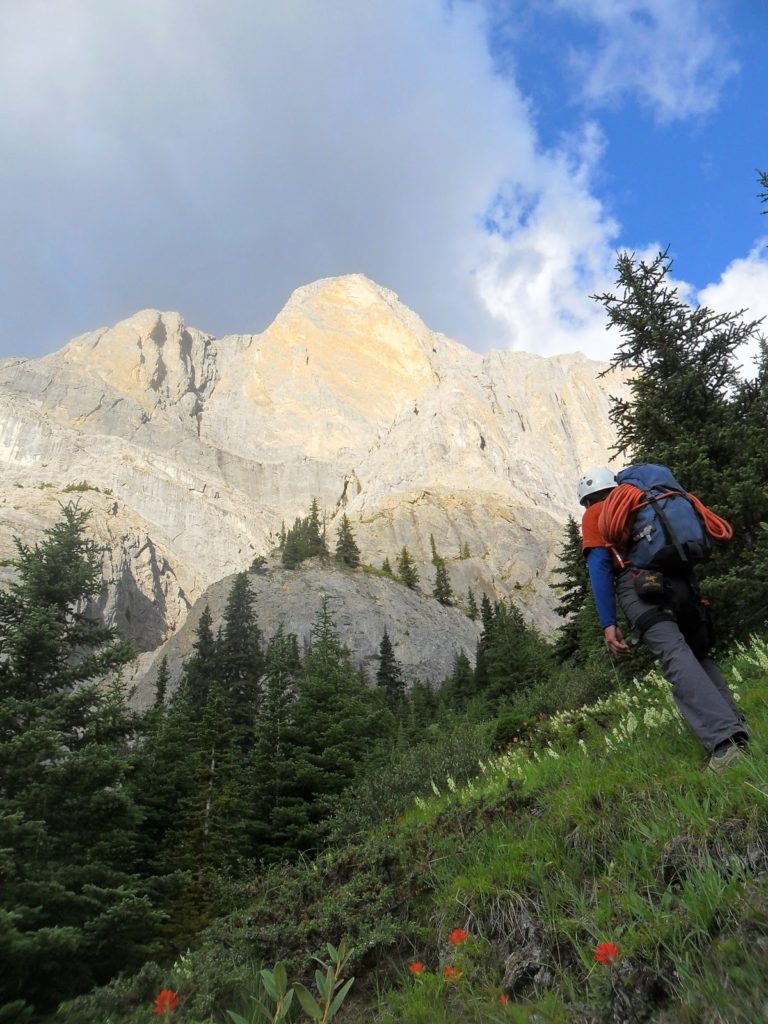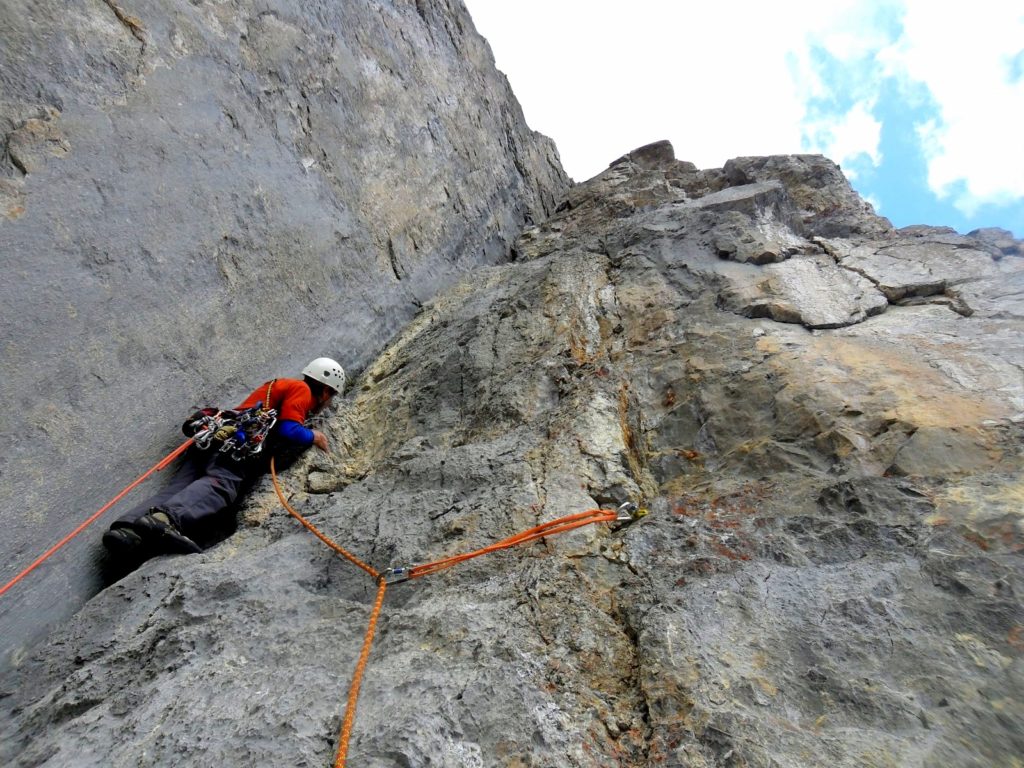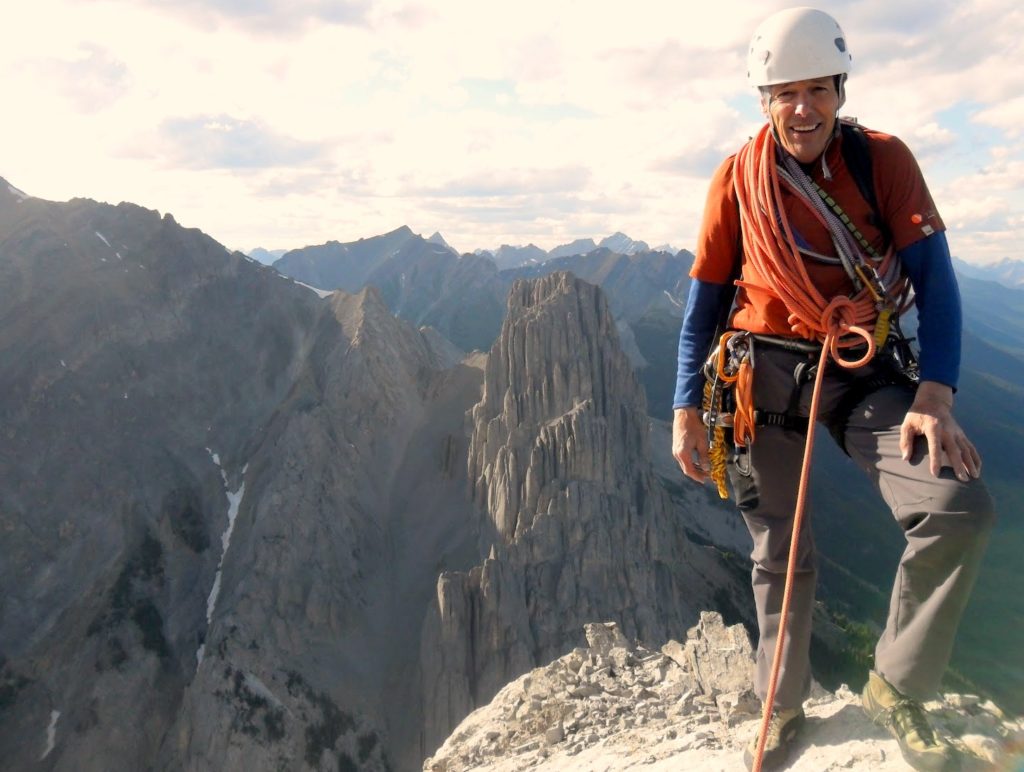Canadian climbing legend Tim Auger has passed away in Banff at the age of 72. He had been struggling with health problems for a few years.
Auger was one of Canada’s leading climbers from the 1960s onward and played an important role in Banff National Park as a search and rescue technician who assisted in countless rescues in western Canada.
Auger was born in Toronto in 1946 and grew up in Vancouver where his father was a newspaper publisher. At age 13, he read Heinrich Harrer’s book The White Spider about the North Face of the Eiger and he knew then that he wanted to be a climber.
Auger started climbing in his late teens and in 1964, at age 18, he and Dan Tate made the second ascent of the Grand Wall in Squamish. “I thought I’d died and gone to heaven”, said Auger after the climb.
He and Tate slept on the ledge above the Split Pillar on the Grand Wall for Auger’s first bivy. He said he recalled images from The White Spider, “I realized that I was doing what I had dreamed about. This was my version of the Swallow’s Nest. You actually had to sleep sitting up. It was a pretty neat experience for a couple of kids.”

Photo Pat Morrow
Like many climbers from his generation, Auger was inspired by the Himalayan alpinists of the day and often referred to Walter Bonatti and Fosco Maraini’s book, Karakoram: The Ascent of Gasherbrum IV.
Three years later, Auger was joined by Tate, Glenn Woodsworth and Hamish Mutch for the first ascent of University Wall. The route became a Canadian classic and is on many climber’s tick list. It was called University Wall because Auger was supposed to be in class.
Auger later recalled, “We were fascinated with the toys, with the equipment and technical climbing. It seemed to separate us from the mountaineers of the day.”
After his new-routing exploits in Squamish and with an arts degree from University of British Columbia, Auger moved to the Canadian Rockies and joined the trail crew at Yoho National Park.
For the next six years, he was based at Lake O’Hara beneath big peaks like Hungabee and Lefroy. “It’s the most beautiful place on earth, but don’t tell anybody,” he would say.
Auger began visiting Yosemite and would write about his and other Canadian’s trips to climb El Capitan and Half Dome. He would document accomplishments and was known as the storyteller who could entertain around camp fires and in huts.
In the 1970 Canadian Alpine Journal, Auger wrote the following about a trip to Yosemite:
In the spring of 1969, many Canadian climbers found their way to Yosemite. Gordie Smaill and Neil Bennett of Vancouver stayed over a month, and together climbed Washington Column (South Face), the West Face of Leaning Tower, the Kor-Fredericks route on Sentinel Rock, and finally The Nose on El Capitan (first Canadian ascent). With American partners, Smaill climbed the West Face of Sentinel, East Face of Washington Column, and the Dihedral Wall on El Capitan (one of the greatest aid problems anywhere). In the fall, Canadians returned again, even more numerous. Smaill climbed the Salathe Wall in four days with Al Givler of Seattle. Mike Wisnicki and I climbed the South Face of Washington Column. Days later, climbing with Bennett, I broke my ankle in a fall on the North Face of the Rostrum. The spring of 1970 saw even more Canadians arriving and many fine ascents have already been done.
Despite living in the Canadian Rockies, Auger kept tabs on what was happening in Squamish. “The trend in climbing on The Chief reflected the new popularity of big wall climbing, with more climbers launching themselves on continuous ascents of the longer routes,” he wrote for the Canadian Alpine Journal.
In the mid-1970s, Auger moved Banff National Park and joined the rescue group, which he helped grow into one of the world’s top mountain rescue teams as a leading rescue technician.
He helped refine helicopter sling rescue systems, worked to develop rescue pilot standards and was an important member of early research into avalanche probing methods.
Auger would continue to climb in California and made ascents of Triple Direct on El Capitan and made the first winter ascent of the East Face of Keeler Needle on Mount Whitney with Galen Rowell.
He was also an early pioneer of big and steep ice routes in the Rockies and made the first ascents of Bourgeau Right and Bourgeau Left. He went on to climb the South Ridge of Pumori in Nepal and was a member of the Canadian Mount Everest Expedition in 1982. Auger climbed the East Ridge of Mount Logan and survived a 600-metre fall during the descent.
Back in the Canadian Rockies, he made the first ascents of many of today’s multi-pitch classics, including Homage to the Spider on Mount Louis and Ultra Brewers on Castle Mountain.
He soloed the Kain Route on Mount Louis countless times and often spoke highly of his hero Walter Perren, who made the first ascent of the Perren Cracks on the Kain Route in the 1950s. Auger named Homage to the Spider in honour of Perren, who was known as The Spider of Zermatt in Switzerland.
One of Auger’s favourite places to climb was on Yamnuska, a large multi-pitch wall west of Calgary. “In the Rockies, when you’re climbing somewhere else, when you’re on the north face of Alberta or on the east face of Babel, you’re always comparing it to Yamnuska,” said Auger. “First you climb the ice, then you climb Yamnuska, then you put your crampons on and you climb some more ice and you’re on top.”
In 1971, Auger joined Don Vockeroth, one of the Rockies’ leading route developers of the time, on his Yamnuska project and helped in making the first ascent of Kahl Wall. It is now one of the most sought-after Yamnuska 5.10 climbs.

Auger then teamed up with strong climber Joe Josephson and made an early repeat of The Heat is On, a bold route on Yamnuska. “It’s right on the limit of what you can keep doing with enough ease that you can risk going on without pro,” said Auger. “It’s run-out; it’s a real mind trip. I managed to lead most of it because I had the tricks, the tools.”
In 1992, he and Peter Arbic made the seventh ascent of The Lowe/Glidden on the north face of Mount Alberta. Auger said that when they were high on the face, they saw other climbers approaching and yodeled to warn them of potential overhead hazard. It’s well known in the Rockies that you don’t want to climb beneath others on big routes because of potential rockfall. The approaching climbers turned around. That night, during their bivy, Auger and Arbic heard a thunderous rockfall. When the sun rose, they could see the debris field on the glacier below. Auger said it would’ve taken out the lower climbers if they hadn’t turned around.
He said that one of this best climbing moments was the third ascent of the 700-metre East Face of Mount Babel, a run-out and loose wall with hard moves above questionable protection. Auger continued to climb into his 60s and would make a seasonal trip to Mount Louis. In 2010, he and longtime friend Urs Kallen repeated Homage to the Spider, but were stranded below the summit in a snow storm. In the morning, they were cold and the rock was unclimbable, so Auger called his search and rescue friends who picked him and Kallen up. They returned the following year and bolted anchors, which has turned the once rarely-climbed route into the busiest on the peak.

Auger’s influence and cutting edge routes will continue to inspire and push climbers for generations. His stories will stay with those he shared them with and the times he had with others will be talked about for days, weeks and the months to come.
“I had some of my finest, most memorable days with you,” said Canadian Rockies mountain guide Larry Stainer. “Thanks for everything. You really were ‘the master of 5.8’ and so much more.”
“Tim was the personification of skill and humility,” said Ken Wylie, author of Buried. “He summed up a lifetime of picking up wrecks in the mountains by saying, ‘people make mistakes.’ There was no judgement.”
Auger excelled on big walls, ice, chossy stone, in the alpine and on big mountains. He was a story teller, teacher and mentor, and one of the most important Canadian climbers of his generation.
“You can climb on vertical stuff and overhanging stuff at 5.8. You can finesse your way through pitch after pitch of really beautiful situations where you’re just sharing it with the swallows.” – Tim Auger

Photo Brandon Pullan
Sources: Canadian Alpine Journal, Pushing the Limits by Chic Scott, Banff Mountain Film Festival, The Yam – 50 Years of Climbing on Yamnsuka by Ben Gadd, Chic Scott and Dave Dornian.
